People and Organisations Module: Reflection on Employment
VerifiedAdded on 2023/01/18
|6
|1175
|41
Essay
AI Summary
This essay presents a student's individual personal reflection on employment, drawing from the "People and Organisations" module. The reflection analyzes various organizational structures, including functional, line, and committee organizations, evaluating their pros and cons. The student expresses a preference for functional organizations due to their integrated nature and opportunities for skill development and opinion expression. Furthermore, the essay contrasts classical management theory with human relations theory, favoring the latter for its employee-centric approach and its positive impact on employee motivation and productivity. The reflection concludes by highlighting how the module's content has informed the student's understanding of ideal working cultures and leadership styles, aiding in their future career aspirations. The essay references several academic sources to support its analysis.
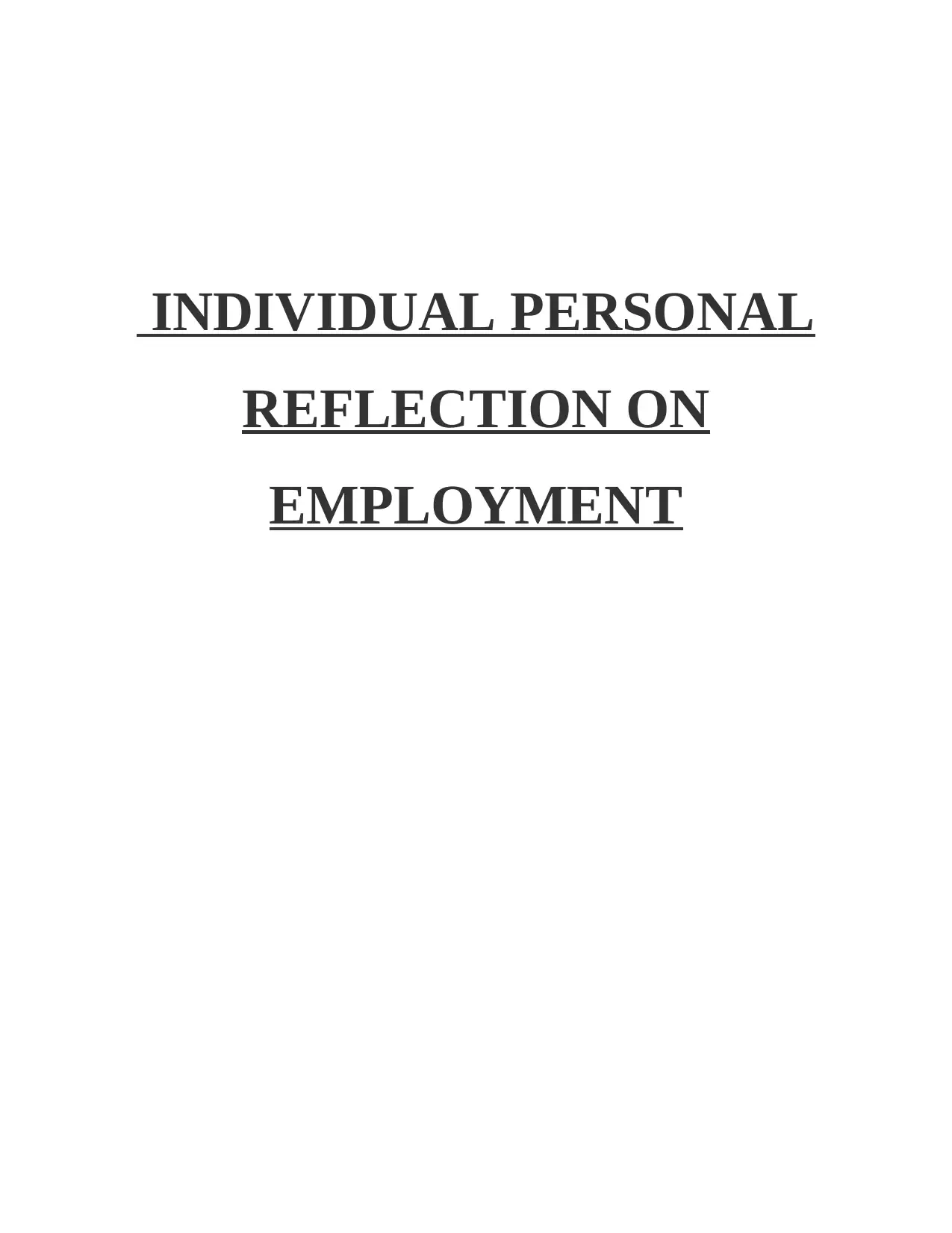
INDIVIDUAL PERSONAL
REFLECTION ON
EMPLOYMENT
REFLECTION ON
EMPLOYMENT
Paraphrase This Document
Need a fresh take? Get an instant paraphrase of this document with our AI Paraphraser
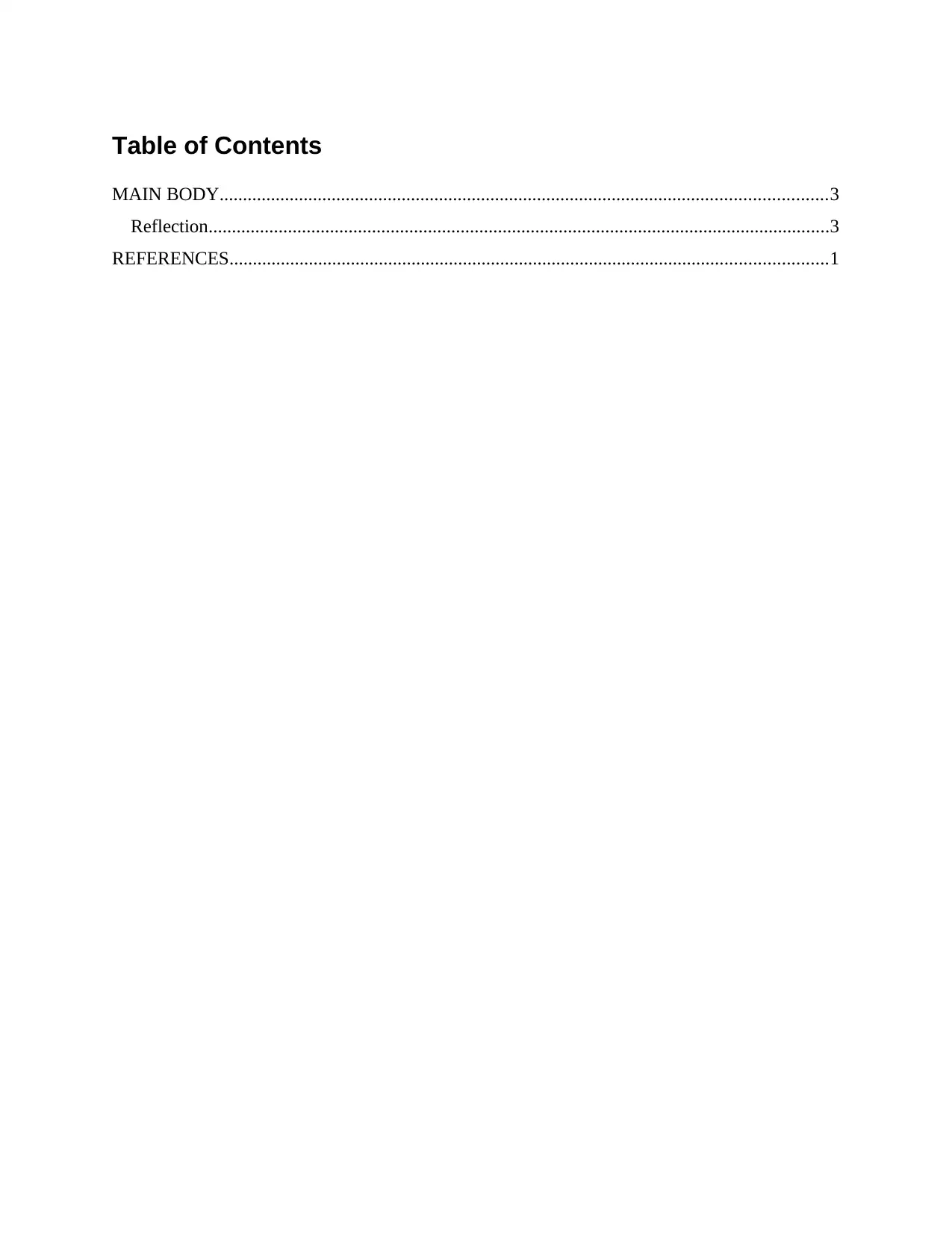
Table of Contents
MAIN BODY..................................................................................................................................3
Reflection.....................................................................................................................................3
REFERENCES................................................................................................................................1
MAIN BODY..................................................................................................................................3
Reflection.....................................................................................................................................3
REFERENCES................................................................................................................................1
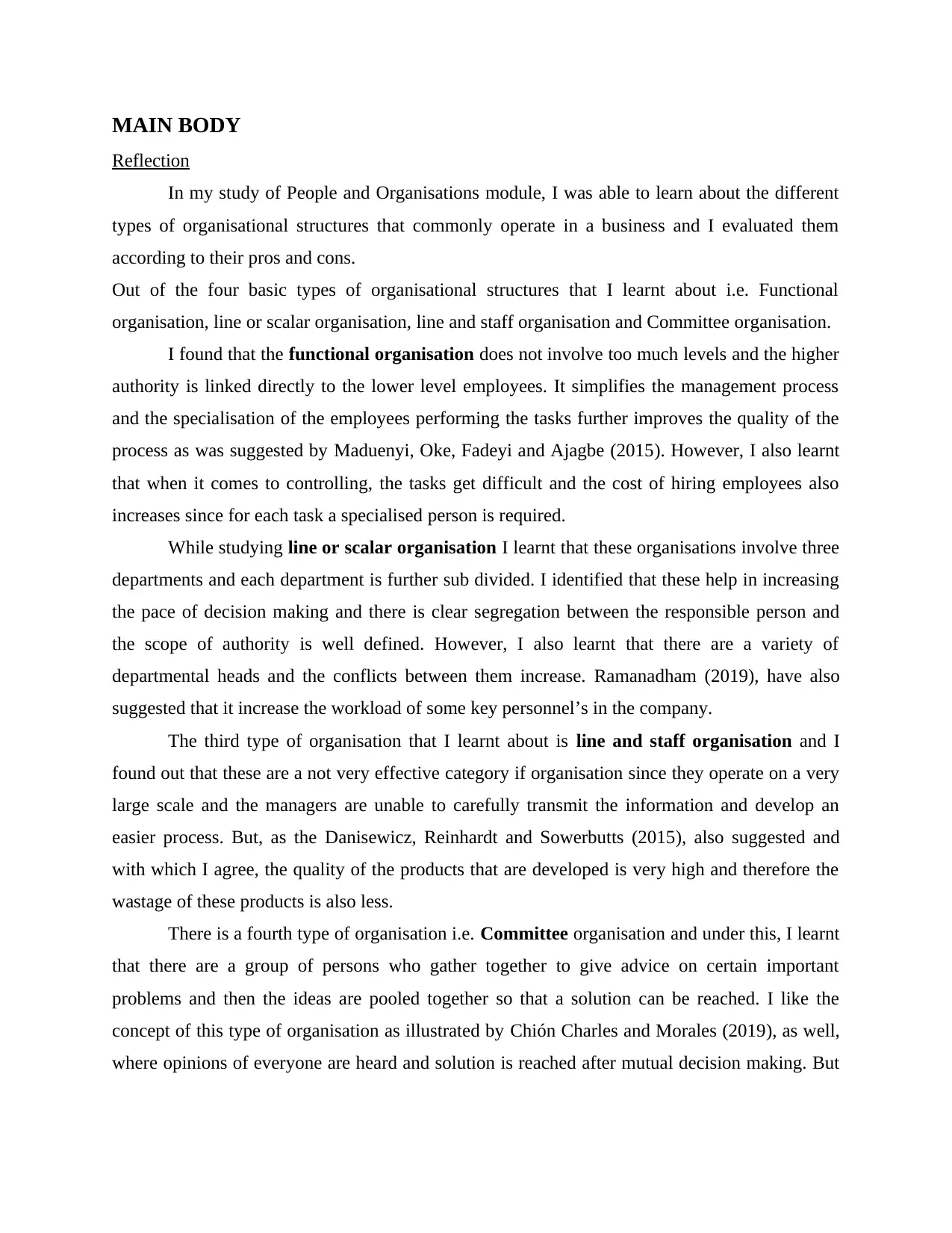
MAIN BODY
Reflection
In my study of People and Organisations module, I was able to learn about the different
types of organisational structures that commonly operate in a business and I evaluated them
according to their pros and cons.
Out of the four basic types of organisational structures that I learnt about i.e. Functional
organisation, line or scalar organisation, line and staff organisation and Committee organisation.
I found that the functional organisation does not involve too much levels and the higher
authority is linked directly to the lower level employees. It simplifies the management process
and the specialisation of the employees performing the tasks further improves the quality of the
process as was suggested by Maduenyi, Oke, Fadeyi and Ajagbe (2015). However, I also learnt
that when it comes to controlling, the tasks get difficult and the cost of hiring employees also
increases since for each task a specialised person is required.
While studying line or scalar organisation I learnt that these organisations involve three
departments and each department is further sub divided. I identified that these help in increasing
the pace of decision making and there is clear segregation between the responsible person and
the scope of authority is well defined. However, I also learnt that there are a variety of
departmental heads and the conflicts between them increase. Ramanadham (2019), have also
suggested that it increase the workload of some key personnel’s in the company.
The third type of organisation that I learnt about is line and staff organisation and I
found out that these are a not very effective category if organisation since they operate on a very
large scale and the managers are unable to carefully transmit the information and develop an
easier process. But, as the Danisewicz, Reinhardt and Sowerbutts (2015), also suggested and
with which I agree, the quality of the products that are developed is very high and therefore the
wastage of these products is also less.
There is a fourth type of organisation i.e. Committee organisation and under this, I learnt
that there are a group of persons who gather together to give advice on certain important
problems and then the ideas are pooled together so that a solution can be reached. I like the
concept of this type of organisation as illustrated by Chión Charles and Morales (2019), as well,
where opinions of everyone are heard and solution is reached after mutual decision making. But
Reflection
In my study of People and Organisations module, I was able to learn about the different
types of organisational structures that commonly operate in a business and I evaluated them
according to their pros and cons.
Out of the four basic types of organisational structures that I learnt about i.e. Functional
organisation, line or scalar organisation, line and staff organisation and Committee organisation.
I found that the functional organisation does not involve too much levels and the higher
authority is linked directly to the lower level employees. It simplifies the management process
and the specialisation of the employees performing the tasks further improves the quality of the
process as was suggested by Maduenyi, Oke, Fadeyi and Ajagbe (2015). However, I also learnt
that when it comes to controlling, the tasks get difficult and the cost of hiring employees also
increases since for each task a specialised person is required.
While studying line or scalar organisation I learnt that these organisations involve three
departments and each department is further sub divided. I identified that these help in increasing
the pace of decision making and there is clear segregation between the responsible person and
the scope of authority is well defined. However, I also learnt that there are a variety of
departmental heads and the conflicts between them increase. Ramanadham (2019), have also
suggested that it increase the workload of some key personnel’s in the company.
The third type of organisation that I learnt about is line and staff organisation and I
found out that these are a not very effective category if organisation since they operate on a very
large scale and the managers are unable to carefully transmit the information and develop an
easier process. But, as the Danisewicz, Reinhardt and Sowerbutts (2015), also suggested and
with which I agree, the quality of the products that are developed is very high and therefore the
wastage of these products is also less.
There is a fourth type of organisation i.e. Committee organisation and under this, I learnt
that there are a group of persons who gather together to give advice on certain important
problems and then the ideas are pooled together so that a solution can be reached. I like the
concept of this type of organisation as illustrated by Chión Charles and Morales (2019), as well,
where opinions of everyone are heard and solution is reached after mutual decision making. But
⊘ This is a preview!⊘
Do you want full access?
Subscribe today to unlock all pages.

Trusted by 1+ million students worldwide
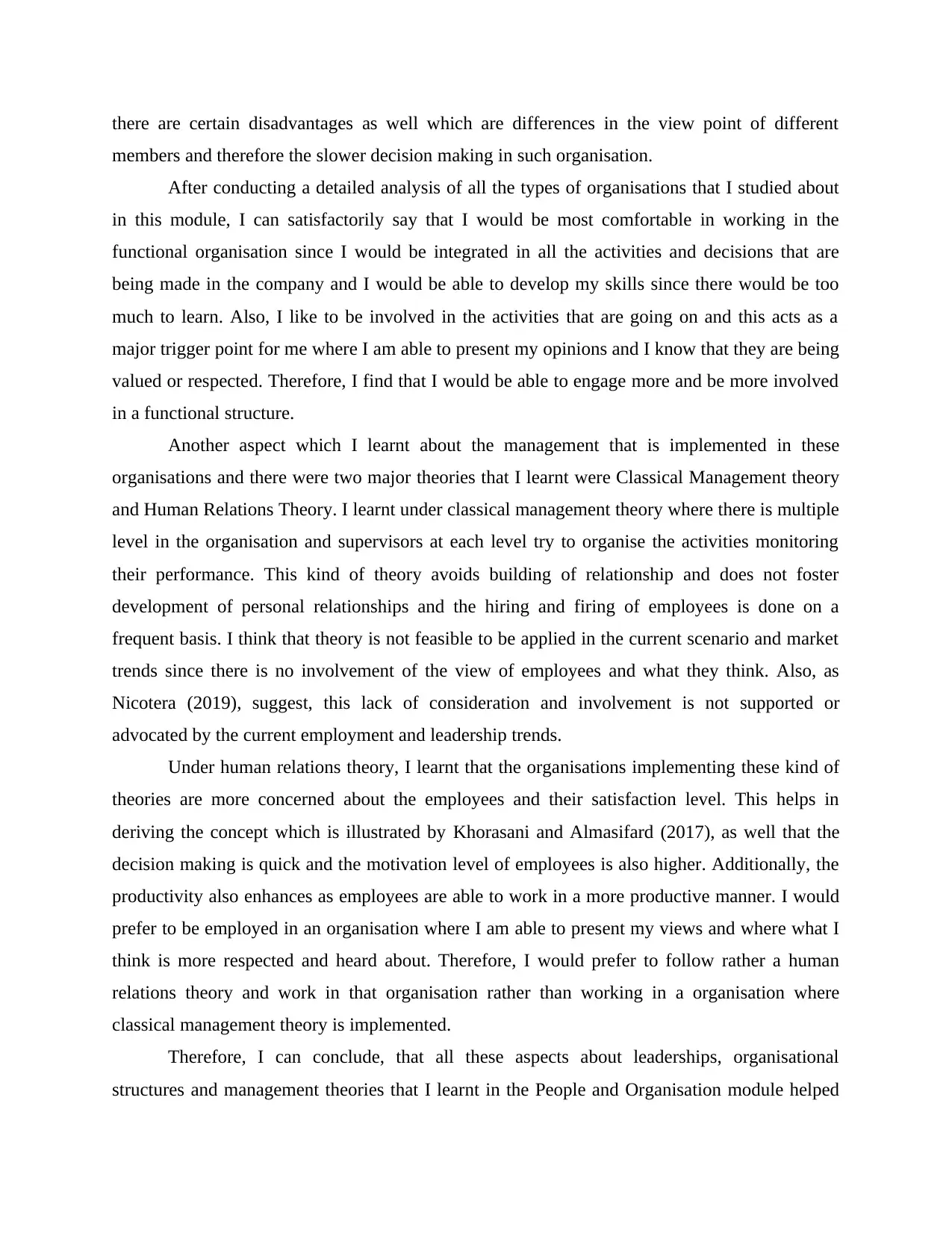
there are certain disadvantages as well which are differences in the view point of different
members and therefore the slower decision making in such organisation.
After conducting a detailed analysis of all the types of organisations that I studied about
in this module, I can satisfactorily say that I would be most comfortable in working in the
functional organisation since I would be integrated in all the activities and decisions that are
being made in the company and I would be able to develop my skills since there would be too
much to learn. Also, I like to be involved in the activities that are going on and this acts as a
major trigger point for me where I am able to present my opinions and I know that they are being
valued or respected. Therefore, I find that I would be able to engage more and be more involved
in a functional structure.
Another aspect which I learnt about the management that is implemented in these
organisations and there were two major theories that I learnt were Classical Management theory
and Human Relations Theory. I learnt under classical management theory where there is multiple
level in the organisation and supervisors at each level try to organise the activities monitoring
their performance. This kind of theory avoids building of relationship and does not foster
development of personal relationships and the hiring and firing of employees is done on a
frequent basis. I think that theory is not feasible to be applied in the current scenario and market
trends since there is no involvement of the view of employees and what they think. Also, as
Nicotera (2019), suggest, this lack of consideration and involvement is not supported or
advocated by the current employment and leadership trends.
Under human relations theory, I learnt that the organisations implementing these kind of
theories are more concerned about the employees and their satisfaction level. This helps in
deriving the concept which is illustrated by Khorasani and Almasifard (2017), as well that the
decision making is quick and the motivation level of employees is also higher. Additionally, the
productivity also enhances as employees are able to work in a more productive manner. I would
prefer to be employed in an organisation where I am able to present my views and where what I
think is more respected and heard about. Therefore, I would prefer to follow rather a human
relations theory and work in that organisation rather than working in a organisation where
classical management theory is implemented.
Therefore, I can conclude, that all these aspects about leaderships, organisational
structures and management theories that I learnt in the People and Organisation module helped
members and therefore the slower decision making in such organisation.
After conducting a detailed analysis of all the types of organisations that I studied about
in this module, I can satisfactorily say that I would be most comfortable in working in the
functional organisation since I would be integrated in all the activities and decisions that are
being made in the company and I would be able to develop my skills since there would be too
much to learn. Also, I like to be involved in the activities that are going on and this acts as a
major trigger point for me where I am able to present my opinions and I know that they are being
valued or respected. Therefore, I find that I would be able to engage more and be more involved
in a functional structure.
Another aspect which I learnt about the management that is implemented in these
organisations and there were two major theories that I learnt were Classical Management theory
and Human Relations Theory. I learnt under classical management theory where there is multiple
level in the organisation and supervisors at each level try to organise the activities monitoring
their performance. This kind of theory avoids building of relationship and does not foster
development of personal relationships and the hiring and firing of employees is done on a
frequent basis. I think that theory is not feasible to be applied in the current scenario and market
trends since there is no involvement of the view of employees and what they think. Also, as
Nicotera (2019), suggest, this lack of consideration and involvement is not supported or
advocated by the current employment and leadership trends.
Under human relations theory, I learnt that the organisations implementing these kind of
theories are more concerned about the employees and their satisfaction level. This helps in
deriving the concept which is illustrated by Khorasani and Almasifard (2017), as well that the
decision making is quick and the motivation level of employees is also higher. Additionally, the
productivity also enhances as employees are able to work in a more productive manner. I would
prefer to be employed in an organisation where I am able to present my views and where what I
think is more respected and heard about. Therefore, I would prefer to follow rather a human
relations theory and work in that organisation rather than working in a organisation where
classical management theory is implemented.
Therefore, I can conclude, that all these aspects about leaderships, organisational
structures and management theories that I learnt in the People and Organisation module helped
Paraphrase This Document
Need a fresh take? Get an instant paraphrase of this document with our AI Paraphraser
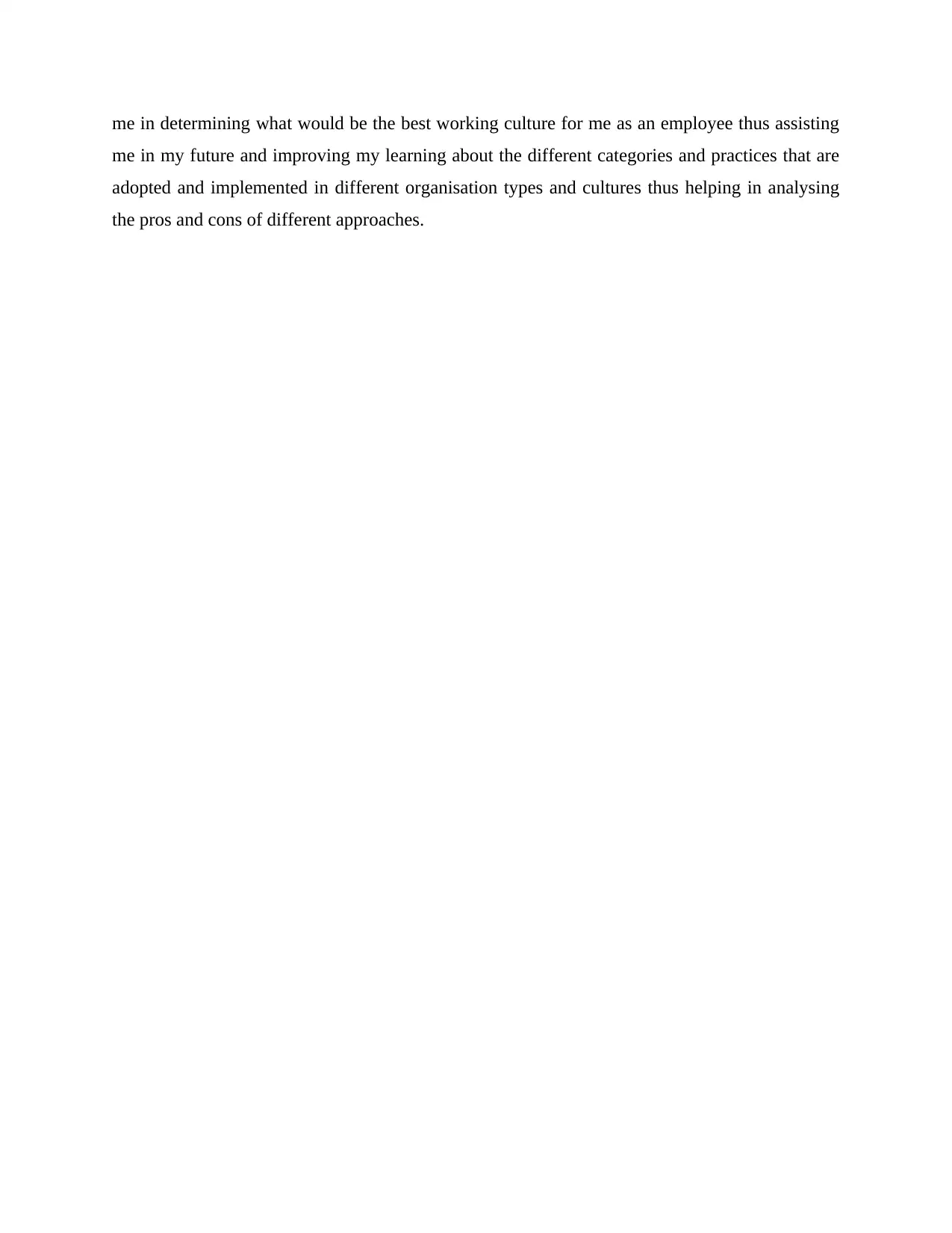
me in determining what would be the best working culture for me as an employee thus assisting
me in my future and improving my learning about the different categories and practices that are
adopted and implemented in different organisation types and cultures thus helping in analysing
the pros and cons of different approaches.
me in my future and improving my learning about the different categories and practices that are
adopted and implemented in different organisation types and cultures thus helping in analysing
the pros and cons of different approaches.
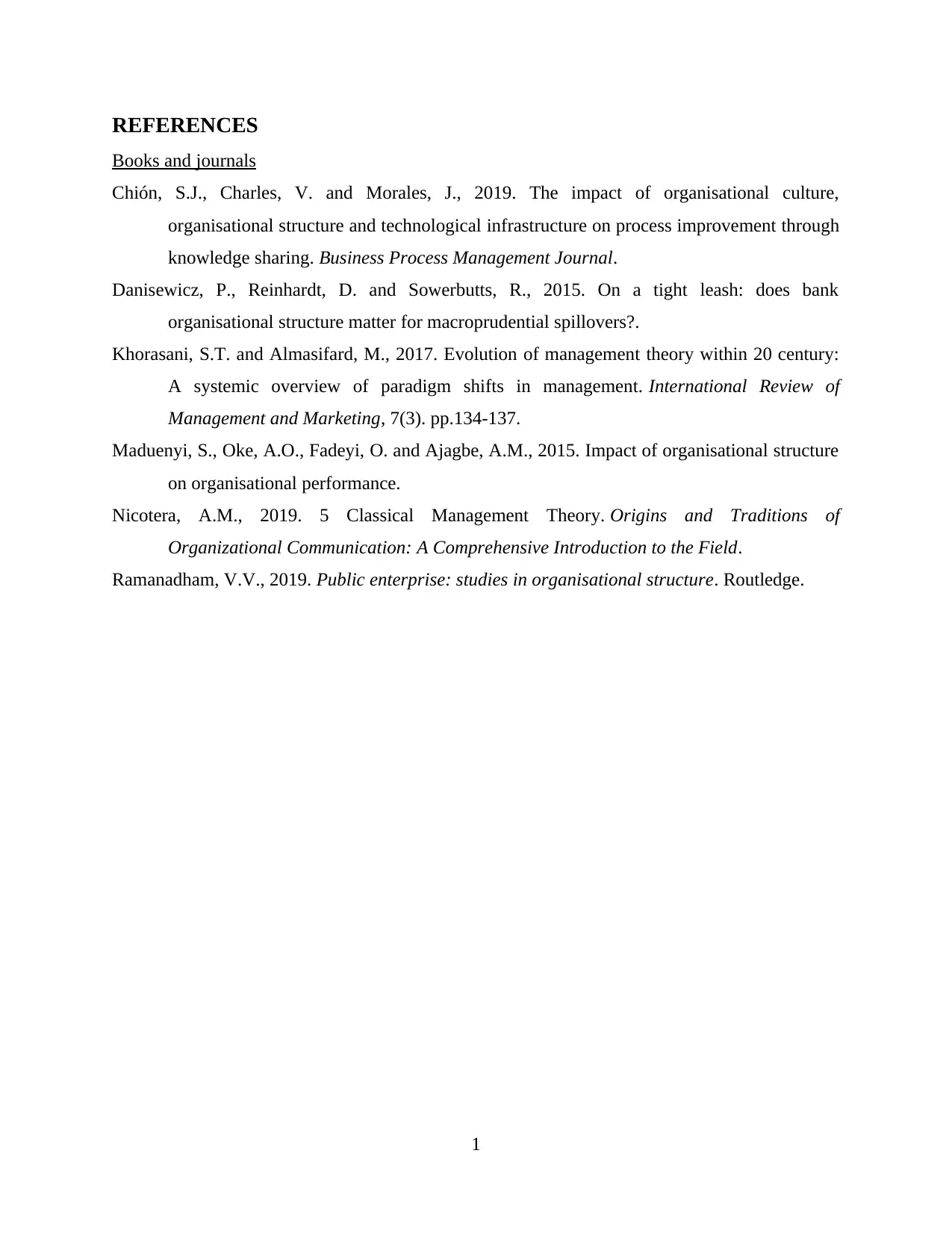
REFERENCES
Books and journals
Chión, S.J., Charles, V. and Morales, J., 2019. The impact of organisational culture,
organisational structure and technological infrastructure on process improvement through
knowledge sharing. Business Process Management Journal.
Danisewicz, P., Reinhardt, D. and Sowerbutts, R., 2015. On a tight leash: does bank
organisational structure matter for macroprudential spillovers?.
Khorasani, S.T. and Almasifard, M., 2017. Evolution of management theory within 20 century:
A systemic overview of paradigm shifts in management. International Review of
Management and Marketing, 7(3). pp.134-137.
Maduenyi, S., Oke, A.O., Fadeyi, O. and Ajagbe, A.M., 2015. Impact of organisational structure
on organisational performance.
Nicotera, A.M., 2019. 5 Classical Management Theory. Origins and Traditions of
Organizational Communication: A Comprehensive Introduction to the Field.
Ramanadham, V.V., 2019. Public enterprise: studies in organisational structure. Routledge.
1
Books and journals
Chión, S.J., Charles, V. and Morales, J., 2019. The impact of organisational culture,
organisational structure and technological infrastructure on process improvement through
knowledge sharing. Business Process Management Journal.
Danisewicz, P., Reinhardt, D. and Sowerbutts, R., 2015. On a tight leash: does bank
organisational structure matter for macroprudential spillovers?.
Khorasani, S.T. and Almasifard, M., 2017. Evolution of management theory within 20 century:
A systemic overview of paradigm shifts in management. International Review of
Management and Marketing, 7(3). pp.134-137.
Maduenyi, S., Oke, A.O., Fadeyi, O. and Ajagbe, A.M., 2015. Impact of organisational structure
on organisational performance.
Nicotera, A.M., 2019. 5 Classical Management Theory. Origins and Traditions of
Organizational Communication: A Comprehensive Introduction to the Field.
Ramanadham, V.V., 2019. Public enterprise: studies in organisational structure. Routledge.
1
⊘ This is a preview!⊘
Do you want full access?
Subscribe today to unlock all pages.

Trusted by 1+ million students worldwide
1 out of 6
Related Documents
Your All-in-One AI-Powered Toolkit for Academic Success.
+13062052269
info@desklib.com
Available 24*7 on WhatsApp / Email
![[object Object]](/_next/static/media/star-bottom.7253800d.svg)
Unlock your academic potential
Copyright © 2020–2025 A2Z Services. All Rights Reserved. Developed and managed by ZUCOL.


